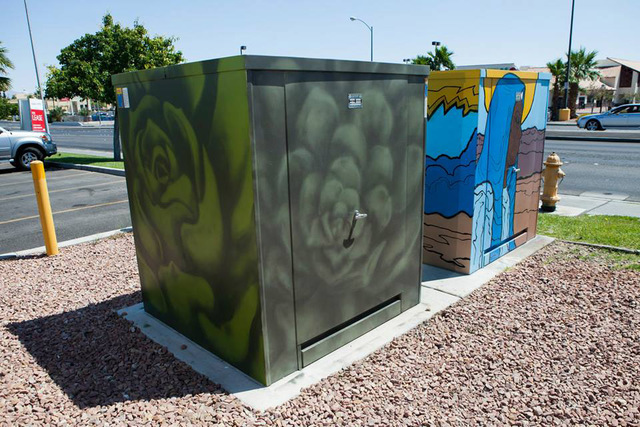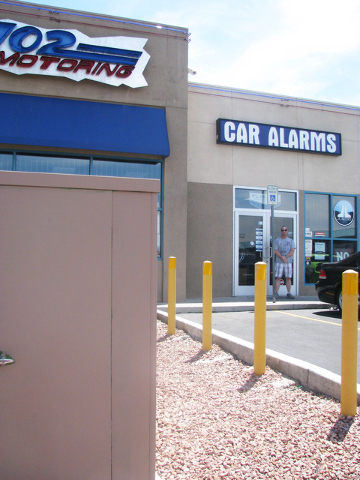Business owner denies involvement in painting over Zap Project artwork
When utility boxes on South Maryland Parkway were painted over to cover public art, suspicion immediately fell to nearby business manager Paul Klein because he had complained about the art before it was finished.
Local artist Lance Smith created the artwork, which featured three images of the same dark-skinned figure in robes, in summer 2015 as part of Clark County’s Zap 7 Project. It was covered in late May with beige paint. Klein denies involvement in the incident.
The art’s concealment on the cube-shaped boxes, which have 5-foot faces, is under investigation, but county officials will try to restore it. Zap Project artworks receive an anti-graffiti coating. The beige paint was scheduled to be removed Friday morning.
Klein dislikes the artwork underneath it.
He identified himself as the manager of 702 Motoring, 3993 S. Maryland Parkway. The utility boxes the murals were painted on are about 15 feet from the front door of Klein’s employer.
“I asked them nicely if they would change the design and not make all three figures black,” Klein said of the work before it was completed in 2015. “I asked if they could maybe make one of the figures white and another Asian or something like that.”
Smith recalls the conversation being less about diversity, but said only that both oral and written complaints were made about the subject matter. Smith said he was trying to achieve diversity with his choice to make the figures black; he believes minorities are underrepresented in public art.
County Commissioner Chris Giunchigliani, whose District E includes the area the art and the store are in, was more specific about Klein’s complaint.
“He was very upset,” she said. “He said he didn’t like it. He said it looked like a Muslim to him.”
Klein said he isn’t a racist. He said his issues with the artwork stemmed from concern over his business and his sales.
“What if someone was coming by here, thinking of coming to my store, and they had had bad experiences with blacks before, like they had been mugged or raped by a black person?” Klein said. “If they saw that picture, they would just drive right by.”
The three figures depicted in Smith’s artwork could be interpreted as desert dwellers or religious figures.
“The figure was meant to be a ‘Watcher’ of the neighborhood, devoid of any particular religious connotation,” Smith said.
The art was part of the latest installation of the county’s Zap Project, a public art initiative started in 2005 and dedicated to beautifying the community. Designs are vetted and displayed in public meetings before work commences.
Michael Ogilvie, a public art cultural specialist overseeing the program, and Patrick Gaffey, cultural program supervisor for Clark County, met with Klein, who said he acknowledged that his complaints were not valid from the county’s standpoint.
Klein said that as far as he was concerned, the issue was over then and he gave no further thought to the art.
When the utility boxes were painted over less than a year after their completion, Giunchigliani came into Klein’s store and confronted him, asking him, “Why did you paint over those boxes?”
“When she asked me, I didn’t know what she was talking about at first,” Klein said. “I hadn’t noticed they’d been painted over.”
Klein believes Giunchigliani has subjected him and his store to special scrutiny following a dispute over advertising flags he put in front of his store without a permit. When he and neighbors in his rural southwest valley neighborhood clashed with developers about building new homes near their property, Klein said Giunchigliani made the case difficult for him and was “very antagonistic.”
The Metropolitan Police Department is investigating the covering of the art, and a detective has interviewed Klein. If a suspect is identified, the case likely wouldn’t be prosecuted as graffiti but as a gross misdemeanor for destruction of private property. The boxes are Las Vegas Valley Water District property.
“It looks like, whoever it was, used exterior paint applied with a roller,” Ogilvie said. “I’m estimating it will take about 10 hours to remove it, and if we’re lucky, it can be done without damaging the artwork underneath. If the art is damaged, we’ll hire Lance to come back and repair it.”
Although the beige paint is not considered graffiti, it’s being cleaned up as such. Graffiti cleanup costs the county $1.6 million a year for abatement.
The artists of Zap 7 were paid $2,350 each to cover supplies and labor. The cost of restoring the work depends on how long cleanup and repainting will take. Ogilvie estimated cleanup could take three to 10 hours.
Smith and county officials feel it is well worth the time and expense.
“I think it’s important for all people, all minorities, to be represented, whether it’s disabled people, queer people, people of color … our voices should not be erased,” Smith said. “At the heart of this, this was an erasure. Whoever did it wanted to take it away and didn’t want anyone to remember it.”
Anyone with information about the vandal or vandals should call Crime Stoppers of Nevada at 702-385-5555. Callers can remain anonymous and may be eligible for a reward if the information leads to a conviction.
To reach East Valley View reporter F. Andrew Taylor, email ataylor@viewnews.com or call 702-380-4532.

































